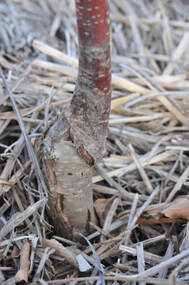
If you want a tree exactly like the parent, you must propagate that tree vegetatively. In the case of apples, this usually means grafting for homeowners. Apple trees are actually quite easy to graft, even for novices. Don't be afraid to try even if you haven't grafted before. The step that needs to be done at this time of year is the choosing and cutting of scion wood or small branches that will be grafted on top of a rootstock. The rootstock is a separate tree that has good root characteristics and often disease resistance. Also rootstocks can have a dwarfing effect on the grafted tree. So our fruit trees are actually two trees spliced together. The roots and beginning of the trunk is the rootstock. The upper portion of the trunk and all the branches is called the scion. It is the “good” part of the tree. For example on apples, the scion might be a Jonathan, Winesap, Granny Smith or any other of a number of different cultivars. The rootstock for all of these varieties may vary or may be the same depending on the desires of the propagator. See the accompanying article in this week’s newsletter for instructions on how to collect scionwood.
If you don’t have an existing tree to graft onto, you will need to plant a rootstock this year for grafting onto next. Fruit trees are normally grafted (or budded) onto specially selected rootstocks. These rootstocks usually reduce tree size. For example, a tree that normally would reach 25 feet tall will only reach 10 feet if it is grown on a certain rootstock. Dwarfing rootstocks also allow apples to bear fruit a year or more earlier.
Note that rootstock reduces tree size, not fruit size. Therefore, a Golden Delicious tree that only reaches 8 feet tall due to a dwarfing rootstock, will bear the same size fruit as a Golden Delicious tree that is 25 feet tall.
A tree on its own roots normally takes 5 to 7 years before it will bear. Semi-dwarf trees bear in 4 to 5 years, and dwarf trees bear in 3 to 4 years. Unfortunately, not all dwarfing rootstocks are well adapted to Kansas conditions. Semi-dwarf trees usually are a better choice for us. Fully dwarfed trees often are uprooted or break at the graft during high winds. Semi-dwarf trees are usually more than 50% the size of a standard (non-dwarfed) tree.
So, where do you buy rootstocks to graft onto? Most nurseries only sell trees that are already grafted. A company that does sell rootstocks is Raintree Nursery, Morton, WA, (360) 496-6400. See https://raintreenursery.com/collections/apple-rootstock for apple rootstocks.
Another is Cummins Nursery, (865) 233-3539, https://www.cumminsnursery.com/buy-trees/index.php?type=rootstock .
What rootstock is best? There are a several choices that should work well in Kansas. An old favorite is Malling-Merton (MM) 111 as it is well-adapted to Kansas conditions and can tolerate heavier soils. Trees will be 80% the size of a “standard” tree. Malling-Merton (MM) 106 is a good choice for well-drained soils. Trees will be about 70% the size of a standard tree. Other rootstocks can be used but make sure they are well-anchored and not described as brittle.
It is also possible to buy a tree from a local nursery and graft your clone onto a side branch. This will give you one tree that produces two different apples. One disadvantage of this method is that it is possible to prune off the special clone by mistake in later years.
This information does not include the details of grafting or budding or subsequent care. The Missouri Extension Service has an excellent publication on grafting at
https://extension.missouri.edu/publications/g6971 as well as a second publication on budding at https://extension.missouri.edu/publications/g6972 .
If you use a knife, be sure to practice your cuts on wood you prune off in March. After you do about 100 cuts, you will start to get the hang of it. A grafting tool can make this job even simpler as it makes the proper cut automatically. Do a search on “grafting tool” to see what is available.
If you find grafting intimidating, Raintree Nursery does custom grafts. In other words, you must collect your own scionwood and send it to Raintree Nursery. They will make the graft and send it back to you. See https://raintreenursery.com/collections/pear-rootstock/products/custom-graft for details. (Ward Upham)
 RSS Feed
RSS Feed
